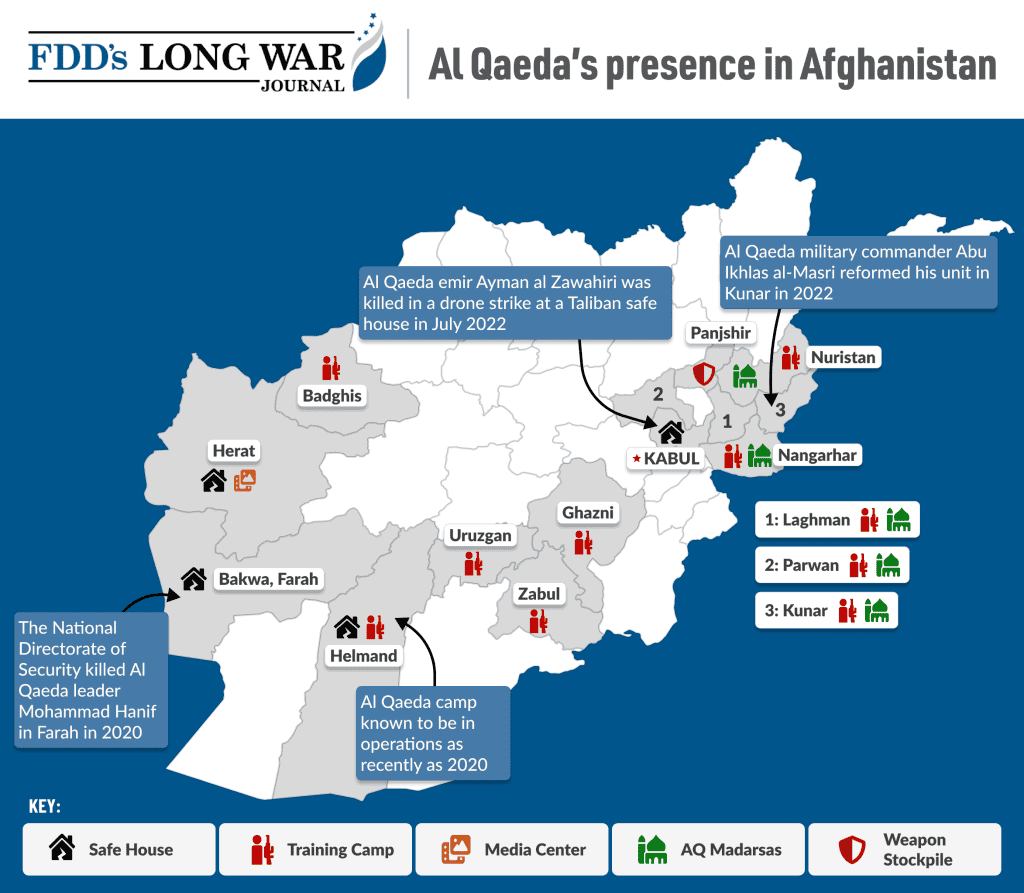
Al Qaeda opened eight new training camps, five madrasas, a weapons depot and safe houses in Afghanistan that are used to facilitate the movement of its members to and from Iran. Additionally, “the relationship between the Taliban and Al-Qaida remains close,” the United Nations Analytical Support and Sanctions Monitoring Team reported.
The presence of new Al Qaeda training camps and other infrastructure inside Afghanistan was disclosed by the United Nations Analytical Support and Sanctions Monitoring Team, which issued its latest report on Afghanistan on January 29.
The eight Al Qaeda camps have been opened in the provinces of Ghazni, Laghman, Parwan and Uruzgan. “Some camps might be temporary,” the Monitoring Team noted.
Al Qaeda is now operating training camps in 10 of Afghanistan’s 34 provinces. In its previous report, the Monitoring Team reported that Al Qaeda was operating training camps in Helmand, Zabul, Nangarhar, Nuristan, Badghis, and Kunar. An Al Qaeda leader known as Hakim al-Masri is “is responsible for the training camps and conducting suicide bomber training for TTP.”
In the central province of Panjshir, the former bastion of the anti-Taliban National Resistance Front, Al Qaeda has established a new base “to stockpile weaponry.” Al Qaeda is also operating five madrasas, or religious schools, in Laghman, Kunar, Nangarhar, Nuristan and Parwan provinces.
Al Qaeda and the Iran connection
In Herat, Farah and Helmand provinces, Al Qaeda “maintains safe houses to facilitate the movement [of members] between Afghanistan and the Islamic Republic of Iran,” as well as safe houses in Kabul.
At least one Al Qaeda safe house in Kabul was exposed in July 2022, when the U.S. killed Ayman al Zawahiri, the co-founder and previous emir of Al Qaeda. Zawahiri was killed in a drone strike as he sheltered in a safe house that was run by a lieutenant of Sirajuddin Haqqani, who is one of the Taliban’s two deputy emirs as well as the current interior minister. Sirajuddin’s powerful Haqqani Network is listed as a Foreign Terrorist Organization for its close ties to Al Qaeda. Sirajuddin and many of his top lieutenants are also labeled as Specially Designated Global Terrorists by the U.S.
The Monitoring Team’s previous report noted that Al Qaeda operated safe houses in these four provinces, but did not disclose that the infrastructure in Herat, Farah and Helmand were used to facilitate travel of leaders and members to and from Iran.
Herat, Farah and Helmand provinces are on the border with Iran, where Al Qaeda leaders are known to shelter. The Monitoring Team noted that “individuals travelling to provide liaison between Al Qaeda’s de facto leader, Saif al Adel, in the Islamic Republic of Iran and senior Al Qaeda figures in Afghanistan, including Abdul Rahman al-Ghamdi.”
“Six new Al-Qaida operatives were reported to have moved to eastern Afghanistan to join Katiba Umar Faruq under the leadership of Abu Ikhlas al-Masri.”
A previous Sanctions and Monitoring Team report noted that Abu Ikhlas al-Masri, a veteran Al Qaeda leader, had reestablished his unit in Kunar province after the fall of the Afghan government in August 2021. Prior to his capture by U.S. forces in 2010, Abu Ikhlas al-Masri ran training camps in Kunar, where he served as Al Qaeda’s chief of operations. Abu Ikhlas al-Masri and other Al Qaeda, Islamic State and other terrorist leaders and operatives were freed from Bagram prison after it fell to the Taliban in the summer of 2021.
The presence of top Al Qaeda leaders inside Iran has been documented by the U.S. government in numerous designations over the years. Other senior leaders known to have been operating inside Iran include ‘Abd al Rahman al Maghrebi, Yasin al Suri, Sa’ad bin Laden (now deceased), and Mustafa Hamid. [For a list of Al Qaeda leaders, operatives and facilitators operating in Iran, see FDD’s Long War Journal report, U.S. identifies additional al Qaeda leaders in Iran.]
In addition to keeping tabs on senior Al Qaeda figures inside Iran, the U.S. Treasury and State Departments have repeatedly exposed Iran’s “secret deal” with the Sunni jihadists. Under an agreement with the Iranian regime, Al Qaeda has maintained its “core facilitation pipeline” inside Iran. The Iranians have allowed this facilitation network to operate even though Iran and Al Qaeda are on opposite sides of the conflicts in Syria and Yemen.







